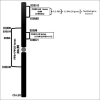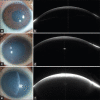Updates on congenital hereditary endothelial dystrophy
- PMID: 38249503
- PMCID: PMC10798399
- DOI: 10.4103/tjo.TJO-D-23-00135
Updates on congenital hereditary endothelial dystrophy
Abstract
Congenital hereditary endothelial dystrophy (CHED) is a rare genetic corneal disorder causing progressive cornea clouding and significant visual impairment. CHED remains a leading indication for pediatric corneal transplantation despite its infrequency, particularly in regions with high consanguinity rates like Southeast Asia. Identifying the Solute Carrier Family 4 Member 11 (SLC4A11) gene as the genetic basis of CHED has led to the discovery of it's various genetic variations. However, a comprehensive understanding of its clinical-genetic correlation, pathophysiology, and optimal management is ongoing. This review aims to consolidate current knowledge about CHED, covering its genetic origins, pathophysiological mechanisms, clinical presentation, and management strategies. Surgical intervention, such as penetrating keratoplasty (PK), Descemet stripping automated endothelial keratoplasty (DSAEK), and Descemet membrane endothelial keratoplasty (DMEK), remains the primary treatment. DSAEK and DMEK offer advantages over PK, including quicker visual recovery, reduced complications, and longer graft survival, especially in the pediatric age group. The timing of surgical interventions depends on disease severity, age at presentation, comorbidities, and visual potential. Elevated oxidative stress in CHED corneal tissue suggests potential benefits from anti-inflammatory drugs to rescue mutated endothelial cells. Considering the limitations of corneal graft surgeries, exploring novel gene-based molecular therapies are essential for future management. Early diagnosis, appropriate surgical interventions, amblyopia control, and genetic counseling for predictive analysis are pivotal for optimizing CHED management. A multidisciplinary approach involving ophthalmologists, researchers, and genetic counselors is essential for precise diagnosis and optimal care for CHED patients.
Keywords: Congenital hereditary endothelial dystrophy; Solute Carrier Family 4 Member 11 (SLC4A11); corneal endothelial dystrophies in childhood.
Copyright: © 2023 Taiwan J Ophthalmol.
Conflict of interest statement
The authors declare that there are no conflicts of interests of this paper.
Figures





Similar articles
-
Novel Proposed Algorithm in Congenital Hereditary Endothelial Dystrophy.Semin Ophthalmol. 2023 Feb;38(2):108-115. doi: 10.1080/08820538.2022.2094713. Epub 2022 Jun 28. Semin Ophthalmol. 2023. PMID: 35763407 Review.
-
A review of techniques and outcomes of endothelial keratoplasty in congenital hereditary endothelial dystrophy.Indian J Ophthalmol. 2022 Dec;70(12):4108-4117. doi: 10.4103/ijo.IJO_1313_22. Indian J Ophthalmol. 2022. PMID: 36453297 Free PMC article. Review.
-
Penetrating Keratoplasty Versus Descemet Stripping Automated Endothelial Keratoplasty in Children With Congenital Hereditary Endothelial Dystrophy: Long-Term Results.Eye Contact Lens. 2022 Dec 1;48(12):521-526. doi: 10.1097/ICL.0000000000000942. Epub 2022 Sep 21. Eye Contact Lens. 2022. PMID: 36138016
-
Descemet Stripping Automated Endothelial Keratoplasty versus Descemet Membrane Endothelial Keratoplasty for Fuchs Endothelial Corneal Dystrophy: A National Registry-Based Comparison.Ophthalmology. 2023 Dec;130(12):1248-1257. doi: 10.1016/j.ophtha.2023.07.024. Epub 2023 Jul 28. Ophthalmology. 2023. PMID: 37517576
-
Outcomes of Descemet membrane endothelial keratoplasty, Descemet stripping automated endothelial keratoplasty and penetrating keratoplasty from a single centre study.Graefes Arch Clin Exp Ophthalmol. 2016 Mar;254(3):515-22. doi: 10.1007/s00417-015-3248-z. Epub 2016 Jan 7. Graefes Arch Clin Exp Ophthalmol. 2016. PMID: 26743748
Cited by
-
SLC4A11 Revisited: Isoforms, Expression, Functions, and Unresolved Questions.Biomolecules. 2025 Jun 16;15(6):875. doi: 10.3390/biom15060875. Biomolecules. 2025. PMID: 40563515 Free PMC article. Review.
-
Comparative study of effectiveness and safety between non-Descemet stripping endothelial keratoplasty and Descemet stripping endothelial keratoplasty for endothelial decompensation.Front Med (Lausanne). 2025 May 20;12:1499422. doi: 10.3389/fmed.2025.1499422. eCollection 2025. Front Med (Lausanne). 2025. PMID: 40463969 Free PMC article.
-
Comparison and Correlation of the Donor-Recipient Interface Changes and Visual Outcomes Between nDSEK and DSEK.J Ophthalmol. 2025 Mar 12;2025:2066562. doi: 10.1155/joph/2066562. eCollection 2025. J Ophthalmol. 2025. PMID: 40224289 Free PMC article.
-
Keratoplasty: are children missing out on the lamellar revolution-the 2023 Bowman Club, David L. Easty Lecture.BMJ Open Ophthalmol. 2024 Oct 24;9(1):e001804. doi: 10.1136/bmjophth-2024-001804. BMJ Open Ophthalmol. 2024. PMID: 39455068 Free PMC article.
-
The 2023 Doyne Lecture-a cornea care system: evolution.Eye (Lond). 2024 Oct;38(15):2888-2897. doi: 10.1038/s41433-024-03206-x. Epub 2024 Jul 8. Eye (Lond). 2024. PMID: 38977821 Free PMC article.
References
-
- Kenyon KR, Antine B. The pathogenesis of congenital hereditary endothelial dystrophy of the cornea. Am J Ophthalmol. 1971;72:787–95. - PubMed
-
- Maumenee AE. Congenital hereditary corneal dystrophy. Am J Ophthalmol. 1960;50:1114–24. - PubMed
-
- Antine B. Histology of congenital hereditary corneal dystrophy. Am J Ophthalmol. 1970;69:964–9. - PubMed
Publication types
LinkOut - more resources
Full Text Sources
Molecular Biology Databases
